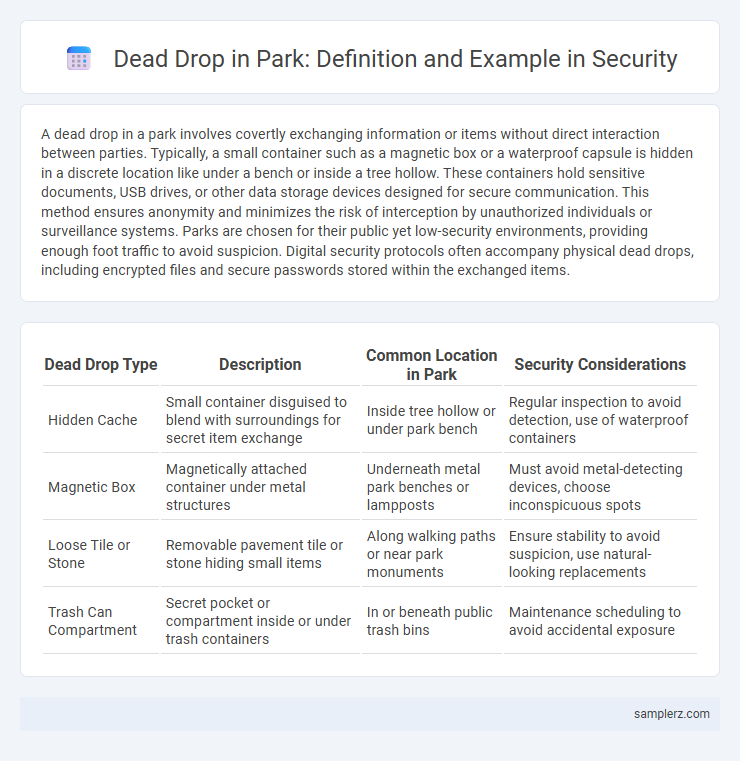A dead drop in a park involves covertly exchanging information or items without direct interaction between parties. Typically, a small container such as a magnetic box or a waterproof capsule is hidden in a discrete location like under a bench or inside a tree hollow. These containers hold sensitive documents, USB drives, or other data storage devices designed for secure communication. This method ensures anonymity and minimizes the risk of interception by unauthorized individuals or surveillance systems. Parks are chosen for their public yet low-security environments, providing enough foot traffic to avoid suspicion. Digital security protocols often accompany physical dead drops, including encrypted files and secure passwords stored within the exchanged items.
Table of Comparison
| Dead Drop Type | Description | Common Location in Park | Security Considerations |
|---|---|---|---|
| Hidden Cache | Small container disguised to blend with surroundings for secret item exchange | Inside tree hollow or under park bench | Regular inspection to avoid detection, use of waterproof containers |
| Magnetic Box | Magnetically attached container under metal structures | Underneath metal park benches or lampposts | Must avoid metal-detecting devices, choose inconspicuous spots |
| Loose Tile or Stone | Removable pavement tile or stone hiding small items | Along walking paths or near park monuments | Ensure stability to avoid suspicion, use natural-looking replacements |
| Trash Can Compartment | Secret pocket or compartment inside or under trash containers | In or beneath public trash bins | Maintenance scheduling to avoid accidental exposure |
Understanding Dead Drops: A Brief Overview
Dead drops in parks serve as covert communication points where individuals can exchange information or items without direct contact, enhancing operational security. These hidden caches utilize natural or man-made structures, such as benches, tree hollows, or buried containers, to avoid detection. Effective use of dead drops requires meticulous planning and awareness of counter-surveillance techniques to prevent compromise.
Why Parks Are Chosen for Dead Drops
Parks offer a discreet environment with natural cover, making them ideal locations for dead drops in security operations. The frequent presence of pedestrians and varied scenery helps mask the exchange of sensitive information, reducing suspicion. Their accessibility and public yet semi-private nature balance safety with anonymity, optimizing covert communication.
Classic Methods: How Dead Drops Are Concealed in Parks
Classic dead drops in parks often involve hiding small containers inside hollowed-out tree branches or beneath loose park benches, blending seamlessly with the natural environment. Concealment techniques exploit everyday objects like weatherproofed rocks or buried tins covered with leaves and dirt for discreet exchanges. These traditional methods leverage inconspicuous locations that avoid surveillance and casual detection, maintaining operational security in covert communications.
Notable Historical Examples of Park Dead Drops
Notable historical examples of park dead drops include the Berlin Wall era, where spies used hollowed-out tree stumps and park benches in Tiergarten Park to exchange secret messages and microfilms. In Central Park, New York, during the Cold War, dead drops were ingeniously concealed within flowerbeds and under rocks, enabling covert communication between intelligence agents. These methods highlight the strategic use of public green spaces for secure espionage activities throughout history.
Modern Technology and Park-Based Dead Drops
Park-based dead drops utilize modern technology such as NFC tags and encrypted USB devices discreetly embedded in benches or trees, enabling secure, covert data exchange without direct contact. These technologically enhanced dead drops benefit from wireless communication protocols and advanced encryption algorithms, ensuring confidentiality and integrity during information transfer. Integration of smartphone apps allows users to seamlessly access and upload data, blending traditional espionage techniques with contemporary digital security measures.
Security Risks Associated with Park Dead Drops
Dead drops in parks present significant security risks, including the potential for covert communication by criminal networks or espionage agents. The open, public nature of parks increases the chance of interception by unintended parties, compromising sensitive information or materials. Environmental factors and lack of surveillance further exacerbate vulnerabilities, making these sites attractive yet insecure locations for clandestine exchanges.
Signs of a Dead Drop in Public Parks
A common sign of a dead drop in public parks is the presence of inconspicuous objects placed unusually or repeatedly in specific locations, such as loose bricks, hollowed tree stumps, or disguised containers near benches. Unexplained marks on trees, rocks, or pathways, like discreet scratches, chalk marks, or unusual paint patterns, can also indicate secret transfer points. Frequent visits by individuals who do not engage in typical park activities, especially if they appear to monitor or retrieve items quickly and discreetly, further suggest the existence of a dead drop.
Counter-Surveillance Tactics for Detecting Dead Drops
Counter-surveillance tactics for detecting dead drops in parks rely heavily on environmental awareness and behavioral analysis, such as monitoring unusual foot traffic patterns and identifying inconspicuous objects like hollowed tree stumps or discreetly placed containers. Surveillance teams often use technology including handheld radio frequency detectors and portable cameras to uncover hidden communication devices or data capsules. Understanding common concealment methods and regularly scanning high-traffic yet secluded park areas enhances the effectiveness of detecting illicit dead drops.
Case Studies: Espionage Using Park Dead Drops
In espionage history, park dead drops have served as covert communication points where agents discreetly exchange classified information using hidden containers in trees or benches. The 2010 case involving a double agent in Central Park highlighted how small, weatherproof capsules concealed within flowerbeds enabled undetected intelligence transfers. Such examples demonstrate the effectiveness of natural urban locations for secure, low-risk espionage operations.
Preventing Unauthorized Dead Drops in Urban Parks
Preventing unauthorized dead drops in urban parks requires integrating advanced surveillance technologies such as AI-powered cameras and motion sensors to detect suspicious activities in real time. Maintaining regular patrols and deploying plainclothes security personnel enhance situational awareness and discourage covert exchanges. Implementing community awareness programs encourages park visitors to report unusual behavior, effectively creating a collaborative security network.

example of dead drop in park Infographic
 samplerz.com
samplerz.com